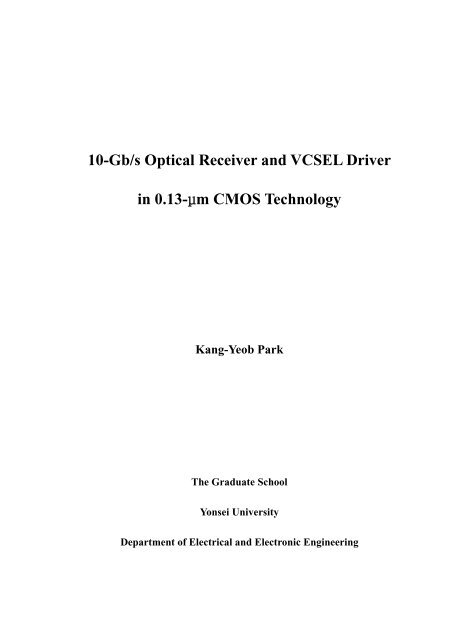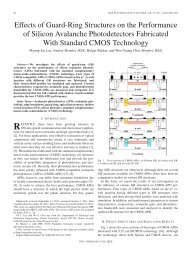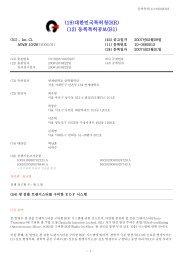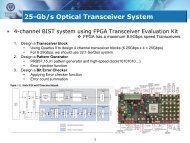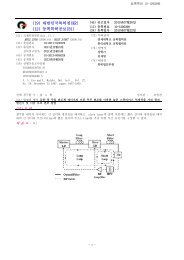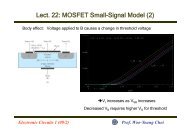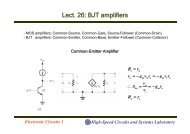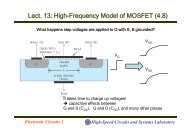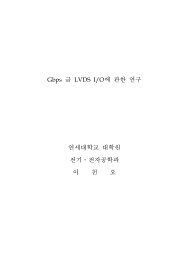10Gbps Optical Receiver and VCSEL Driver in 0.13um CMOS ...
10Gbps Optical Receiver and VCSEL Driver in 0.13um CMOS ...
10Gbps Optical Receiver and VCSEL Driver in 0.13um CMOS ...
Create successful ePaper yourself
Turn your PDF publications into a flip-book with our unique Google optimized e-Paper software.
10-Gb/s <strong>Optical</strong> <strong>Receiver</strong> <strong>and</strong> <strong>VCSEL</strong> <strong>Driver</strong><br />
<strong>in</strong> 0.13-μm <strong>CMOS</strong> Technology<br />
Kang-Yeob Park<br />
The Graduate School<br />
Yonsei University<br />
Department of Electrical <strong>and</strong> Electronic Eng<strong>in</strong>eer<strong>in</strong>g
10-Gb/s <strong>Optical</strong> <strong>Receiver</strong> <strong>and</strong> <strong>VCSEL</strong> <strong>Driver</strong><br />
<strong>in</strong> 0.13-μm <strong>CMOS</strong> Technology<br />
Master’s Thesis<br />
Submitted to the Department of Electrical <strong>and</strong> Electronic Eng<strong>in</strong>eer<strong>in</strong>g<br />
<strong>and</strong> the Graduate School of Yonsei University<br />
<strong>in</strong> partial fulfillment of the requirements<br />
for the degree of Master of Science<br />
Kang-Yeob Park<br />
July 2008
Contents<br />
Figure Index_____________________________________________iv<br />
Table Index_____________________________________________vii<br />
Abstract________________________________________________viii<br />
І. Introduction_____________________________________________1<br />
Ⅱ. 10-Gb/s <strong>Optical</strong> <strong>Receiver</strong> Design_________________________5<br />
Ⅲ. 10-Gb/s <strong>VCSEL</strong> <strong>Driver</strong> Design_________________________31<br />
Ⅳ. IC Fabrication <strong>and</strong> Experiment Results_____________________38<br />
Ⅴ. Conclusion___________________________________________47<br />
Bibliography_____________________________________________49<br />
Abstract (<strong>in</strong> Korean) ______________________________________53<br />
iii
Figure Index<br />
Figure 1.1 Overview of <strong>Optical</strong> L<strong>in</strong>ks__________________________2<br />
Figure 2.1 Block Diagram of an <strong>Optical</strong> <strong>Receiver</strong>_________________6<br />
Figure 2.2 p-i-n Photodiode__________________________________7<br />
Figure 2.3 AC Equivalent Circuit for p-i-n Photodiode_____________8<br />
Figure 2.4 Input <strong>and</strong> Output Signals of TIA_____________________9<br />
Figure 2.5 (a) Input-referred noise current, <strong>and</strong> (b) typical power<br />
spectrum________________________________________________11<br />
Figure 2.6 Common-Gate TIA_______________________________14<br />
Figure 2.7 Feedback TIA___________________________________16<br />
Figure 2.8 Input <strong>and</strong> Output Signals of a fully differential LA______17<br />
Figure 2.9 DC Transfer Characteristic of a LA__________________18<br />
Figure 2.10 Proposed Block Diagram of 10-Gb/s <strong>Optical</strong><br />
<strong>Receiver</strong>________________________________________________19<br />
Figure 2.11 Conventional Common-Source TIA_________________20<br />
iv
Figure 2.12 (a) Common-Gate <strong>and</strong> (b) Advanced Common-Gate Input<br />
Configuration____________________________________________21<br />
Figure 2.13 TIA Ga<strong>in</strong> Stage_________________________________24<br />
Figure 2.14 DC Offset Cancellation Circuit with on-chip passive<br />
LPF____________________________________________________25<br />
Figure 2.15 Limit<strong>in</strong>g Amplifier Ga<strong>in</strong> Stage_____________________26<br />
Figure 2.16 Normalized b<strong>and</strong>width versus N for A tot = 40-dB______27<br />
Figure 2.17 Open-Dra<strong>in</strong> Output Buffer________________________27<br />
Figure 2.18 Frequency Response of <strong>Optical</strong> <strong>Receiver</strong>_____________29<br />
Figure 2.19 Input-Referred Noise Current Spectrum______________29<br />
Figure 2.20 Eye Patterns Accord<strong>in</strong>g to Received <strong>Optical</strong> Power@10-<br />
Gb/s, (a) -8.45-dBm (10-uA), (b) -8.45-dBm (100-uA), (c) -1.5-dBm<br />
(500-uA)________________________________________________30<br />
Figure 3.1 Vertical-Cavity Surface-Emitt<strong>in</strong>g Laser (<strong>VCSEL</strong>)_______31<br />
Figure 3.2 L-I Curves for a Semiconductor Laser________________34<br />
Figure 3.3 Average <strong>Optical</strong> Power <strong>and</strong> Ext<strong>in</strong>ction Ratio___________34<br />
v
Figure 3.4 CML/LVDS Compatible Input Configurations_________35<br />
Figure 3.5 Output <strong>Driver</strong> with Bias <strong>and</strong> Modulation Control_______36<br />
Figure 3.6 Eye Patterns with I MOD Control_____________________37<br />
Figure 3.7 Eye Patterns with I BIAS Control_____________________37<br />
Figure 4.1 Microphotographs of Fabricated 10-Gb/s (a) <strong>Optical</strong><br />
<strong>Receiver</strong> <strong>and</strong> (b) <strong>VCSEL</strong> driver _____________________________39<br />
Figure 4.2 Evaluation Boards of (a) <strong>Optical</strong> <strong>Receiver</strong> <strong>and</strong> (b) <strong>VCSEL</strong><br />
<strong>Driver</strong> _________________________________________________40<br />
Figure 4.3 Test Setup for <strong>Optical</strong> L<strong>in</strong>ks: (a) Block Diagram <strong>and</strong> (b)<br />
Real Picture_____________________________________________41<br />
Figure 4.4 Eye Patterns of the Complete <strong>Optical</strong> L<strong>in</strong>k at Various Data<br />
Rates: (a)1.25-Gb/s, (b)2.5-Gb/s, (c)5-Gb/s, <strong>and</strong> (d)10-Gb/s_______45<br />
Figure 4.5 Measured Bit Error Rates accord<strong>in</strong>g to the Received <strong>Optical</strong><br />
Power for 10-Gb/s 2 31 -1 PRBS______________________________45<br />
vi
Table Index<br />
Table 1. Measurement Results of TX <strong>and</strong> RX___________________46<br />
Table 2. Performance Comparison of <strong>Optical</strong> <strong>Receiver</strong>____________46<br />
vii
Abstract<br />
10-Gb/s <strong>Optical</strong> <strong>Receiver</strong> <strong>and</strong> <strong>VCSEL</strong> <strong>Driver</strong><br />
<strong>in</strong> 0.13-μm <strong>CMOS</strong> Technology<br />
By<br />
Kang-Yeob Park<br />
Department of Electrical <strong>and</strong> Electronic Eng<strong>in</strong>eer<strong>in</strong>g<br />
The Graduate School<br />
Yonsei University<br />
A 10-Gb/s optical receiver <strong>and</strong> <strong>VCSEL</strong> driver are designed <strong>and</strong><br />
implemented <strong>in</strong> 0.13-μm <strong>CMOS</strong> technology. In optical communication<br />
system, the analog front-ends is the most critical component affect<strong>in</strong>g<br />
the whole system speed <strong>and</strong> noise performance. Traditionally, Ⅲ-Ⅴ<br />
compound semiconductors such as GaAs, InP, <strong>and</strong> HEMT have been<br />
exploited to realize the analog front-ends due to their high-speed <strong>and</strong><br />
viii
low-noise characteristics. However, deep-submicron <strong>CMOS</strong><br />
technologies become more attractive due to its low cost <strong>and</strong> high<br />
<strong>in</strong>tegration capacity. And almost optical receivers <strong>and</strong> transmitters over<br />
10-Gb/s operation exploited passive <strong>in</strong>ductor to enhance the b<strong>and</strong>width,<br />
while the area of chipset became large [1]-[3]. In this thesis, we realize<br />
10-Gb/s <strong>CMOS</strong> optical receiver <strong>and</strong> <strong>VCSEL</strong> driver without passive<br />
<strong>in</strong>ductor.<br />
<strong>Optical</strong> receiver <strong>in</strong>cludes transimpedance amplifier (TIA) <strong>and</strong><br />
limit<strong>in</strong>g amplifier (LA). The advanced common-gate (ACG) stage is<br />
exploited as the <strong>in</strong>put configuration of TIA. The ACG <strong>in</strong>put<br />
configuration can effectively isolate the large photodiode capacitance<br />
from the b<strong>and</strong>width determ<strong>in</strong>ation, as provid<strong>in</strong>g virtual-ground <strong>in</strong>put<br />
impedance. And limit<strong>in</strong>g amplifier achieves wide b<strong>and</strong>width us<strong>in</strong>g the<br />
comb<strong>in</strong>ation of active feedback <strong>and</strong> negative impedance compensation.<br />
We estimate p-i-n photodiode has 0.7-A/W responsivity <strong>and</strong> 0.25-pF<br />
parasitic capacitance. An optical receiver achieves 10-Gb/s operations<br />
with 6.6-GHz 3-dB b<strong>and</strong>width for 0.25-pF <strong>in</strong>put parasitic capacitance,<br />
96-dBΩ transimpedance ga<strong>in</strong>, <strong>and</strong> 22-pA/sqrt(Hz) average <strong>in</strong>putreferred<br />
noise current density that corresponds to -16.5-dBm sensitivity<br />
for 10 -12 BER. The whole receiver chip occupies the area of 1.8 ×<br />
1.35 mm 2 , <strong>and</strong> the power dissipation is 54-mW from a s<strong>in</strong>gle 1.2-V<br />
ix
supply.<br />
<strong>VCSEL</strong> driver consists of LVDS/CML compatible pre amplifier,<br />
<strong>and</strong> ma<strong>in</strong> driver. The designed transmitter drives <strong>VCSEL</strong> array,<br />
operat<strong>in</strong>g up to 10-Gb/s with bias control (5~20-mA) <strong>and</strong> modulation<br />
control (5~20-mApp) to obta<strong>in</strong> constant <strong>and</strong> reliable optical output<br />
power. The whole transmitter chip occupies the area of 2.05 × 0.83<br />
mm 2 , <strong>and</strong> dissipates 50-mW from a s<strong>in</strong>gle 1.8-V supply.<br />
Keywords: <strong>Optical</strong> <strong>Receiver</strong>, <strong>VCSEL</strong> <strong>Driver</strong>, Transimpedance<br />
Amplifier, Limit<strong>in</strong>g Amplifier, Active Feedback, <strong>CMOS</strong><br />
x
Chapter Ⅰ<br />
Introduction<br />
1.1 <strong>Optical</strong> Communication<br />
As the technology of communication systems has advanced <strong>in</strong><br />
modern society, the amount of <strong>in</strong>formation transported has <strong>in</strong>creased<br />
enormously. The technology of first the electronic era <strong>and</strong> then the<br />
microelectronic era led to the development of a number of analog <strong>and</strong><br />
digital communication techniques that resulted <strong>in</strong> the <strong>in</strong>stallation <strong>and</strong><br />
expansion of wireless <strong>and</strong> satellite l<strong>in</strong>ks. Many researchers have found<br />
methods to exploit the available b<strong>and</strong>width <strong>and</strong> to exp<strong>and</strong> its capacity<br />
for <strong>in</strong>formation to the po<strong>in</strong>t where fundamental constra<strong>in</strong>ts of noise,<br />
<strong>in</strong>terference, power, cost, <strong>and</strong> other issues began to limit progress <strong>in</strong><br />
electronic communication l<strong>in</strong>ks. Research <strong>in</strong> how to overcome these<br />
limitations brought the next step <strong>in</strong> the evolution of communication<br />
systems, which is the use of optics as a replacement for electronics. The<br />
<strong>in</strong>herent advantages of optics, as compared with conventional<br />
electronics, have led a widespread replacement of copper cables for<br />
communication at data rates above Mbps <strong>and</strong> over kilometers. Wide<br />
b<strong>and</strong>width optical fibers allow high data rates <strong>and</strong> large data capacity<br />
with low transmission loss, which allows vastly <strong>in</strong>creased distances<br />
1
etween repeaters. In addition, a natural immunity to EMI<br />
(electromagnetic <strong>in</strong>terference) helps keep SNRs low <strong>and</strong> permits the<br />
use of optical communication systems <strong>in</strong> noisy environments. As a<br />
consequence of these advantages, optical communication systems have<br />
replaced conventional electronic communication systems <strong>in</strong> longdistance<br />
applications <strong>and</strong> gradually are com<strong>in</strong>g <strong>in</strong>to use <strong>in</strong> networks<br />
<strong>in</strong>volv<strong>in</strong>g short-haul applications [4].<br />
Today optical communication systems are used <strong>in</strong> many<br />
applications such as synchronous digital hierarchy (SDH), synchronous<br />
optical networks (SONET) systems, wavelength division multiplex<strong>in</strong>g<br />
(WDM) network systems, local area networks (LANs), metropolitan<br />
area networks (MANs), fiber-to-the-curb/home/build<strong>in</strong>g/desktop/office<br />
(FTTX), <strong>and</strong> board-to-board <strong>in</strong>terconnections, all of which use optical<br />
fiber for data conveyance.<br />
Figure 1.1 Overview of <strong>Optical</strong> L<strong>in</strong>ks<br />
2
An optical communication system generally has three ma<strong>in</strong> parts: a<br />
transmitter, a transmission medium, <strong>and</strong> a receiver, as shown <strong>in</strong> Fig 1.1.<br />
This structure is similar to that of conventional electronic<br />
communication systems. The difference between two systems is that<br />
optical systems exploit optical fibers as a transmission medium <strong>in</strong>stead<br />
of copper wires. The receiver consists of optical detectors such as p-i-n<br />
photodiode (PIN PD) or avalanche photodiode (APD), transimpedance<br />
amplifier (TIA), <strong>and</strong> limit<strong>in</strong>g amplifier (LA). The transmitter consists<br />
of optical sources such as a laser diode (LD), a light emitt<strong>in</strong>g diode<br />
(LED), or a vertical cavity surface emitt<strong>in</strong>g laser (<strong>VCSEL</strong>) <strong>and</strong> their<br />
driver circuits [5], [6].<br />
This dissertation will focus on the design <strong>and</strong> implementation of 10-<br />
Gb/s optical receiver <strong>and</strong> <strong>VCSEL</strong> driver <strong>in</strong> 0.13-μm st<strong>and</strong>ard <strong>CMOS</strong><br />
technology. At first, backgrounds of optical receiver <strong>and</strong> <strong>VCSEL</strong> driver<br />
will be expla<strong>in</strong>ed, <strong>and</strong> then the design issues <strong>and</strong> circuit details will be<br />
described. Details of dissertation outl<strong>in</strong>e are as follows.<br />
In chapter Ⅱ, 10-Gb/s optical receiver design is discussed. Section<br />
2.1 <strong>in</strong>troduces basic background about optical receiver. In section 2.2,<br />
the design details of transimpedance amplifier <strong>and</strong> limit<strong>in</strong>g amplifier<br />
are presented. And section 2.3 describes simulation results optical<br />
receiver.<br />
3
Next, <strong>in</strong> chapter Ⅲ, 10-Gb/s <strong>VCSEL</strong> driver design is described. At<br />
first, basic background is <strong>in</strong>troduced <strong>in</strong> section 3.1. And then, circuit<br />
details of <strong>VCSEL</strong> driver are described <strong>in</strong> section 3.2. In section 3.3,<br />
post layout simulation results of optical transmitter are discussed.<br />
In chapter Ⅳ, IC fabrication <strong>and</strong> measurement are discussed. In<br />
section 4.1, IC fabrication <strong>and</strong> implementation methods are <strong>in</strong>troduced,<br />
<strong>and</strong> then pr<strong>in</strong>ted-circuit boards (PCBs) design is described <strong>in</strong> section<br />
4.2. Measurement results of fabricated chipsets are discussed <strong>in</strong> section<br />
4.3. At last, chapter Ⅴ summarizes results of 10-Gb/s optical receiver<br />
<strong>and</strong> <strong>VCSEL</strong> driver <strong>in</strong> <strong>CMOS</strong> 0.13-μm technology.<br />
4
Chapter Ⅱ<br />
10-Gb/s <strong>Optical</strong> <strong>Receiver</strong> Design<br />
2.1 Background<br />
The basic optical receiver consists of a photodiode <strong>and</strong> a<br />
transimpedance amplifier. The photodiode is a square law device,<br />
which means the detected electrical current depends on the power of<br />
the <strong>in</strong>cident optical signal. TIA amplifies this electrical current with<br />
sufficient b<strong>and</strong>width, convert<strong>in</strong>g it to a voltage, while add<strong>in</strong>g as little<br />
noise as possible. Generally, the TIA output signal is still not large<br />
enough to reach detectable logic levels (approximately 500-mVpp) so<br />
additional amplification is required <strong>in</strong> the form of a limit<strong>in</strong>g amplifier<br />
(LA). The <strong>in</strong>put signal of LA is amplified until it is saturated at the<br />
amplifier voltage rails. This has the effect of produc<strong>in</strong>g a reasonably<br />
constant output voltage sw<strong>in</strong>g for a wide range of <strong>in</strong>put voltage levels.<br />
If the LA is DC coupled to the TIA, DC offset compensation is required<br />
to prevent the LA from saturat<strong>in</strong>g at one rail. The TIA <strong>and</strong> LA make up<br />
what is generally called the analog front-end of the optical receiver.<br />
After the received signal has been boosted to detectable logic levels,<br />
5
a decision circuit is used to remove the noise from the received signal.<br />
The decision circuit is timed by a clock recovery circuit which extracts<br />
a clock signal from the received data. It is important that the clock<br />
driv<strong>in</strong>g the retimer (flip-flop) has a well-def<strong>in</strong>ed phase relationship<br />
with the received data such that the signal is sampled at the optimum<br />
po<strong>in</strong>t dur<strong>in</strong>g the bit period. F<strong>in</strong>ally, the signal can be multiplexed down<br />
to multiple lower bit rate signals us<strong>in</strong>g a de-multiplexer (DEMUX). A<br />
block diagram of this typical optical receiver is shown <strong>in</strong> Fig 2.1 [7].<br />
Figure 2.1 Block Diagram of <strong>Optical</strong> <strong>Receiver</strong><br />
2.1.1 Photodiode<br />
The first element <strong>in</strong> an optical receiver is the photodiode. It is<br />
important to underst<strong>and</strong> the ma<strong>in</strong> characteristics of this device, namely<br />
responsivity <strong>and</strong> noise, <strong>in</strong> order to be able to discuss <strong>and</strong> calculate the<br />
6
performance of receiver. The photodetector together with the<br />
transimpedance amplifier largely determ<strong>in</strong>e the sensitivity of receiver.<br />
Fig 2.2 shows the conceptual diagram of p-i-n photodiode (PIN PD).<br />
We can write down the light-current relationship for a p-i-n diode<br />
know<strong>in</strong>g that the fraction η of all photons creates electrons. Each<br />
photon has the energy hc/λ <strong>and</strong> each electron carries the charge q, thus<br />
the electrical current (I PD ) can be expressed for a given amount of<br />
optical power (P) illum<strong>in</strong>at<strong>in</strong>g PIN PD:<br />
I PD<br />
λq<br />
= η ⋅ ⋅ P<br />
(2.1)<br />
hc<br />
To simplification we call the constant relat<strong>in</strong>g I PD <strong>and</strong> P the<br />
Responsivity of the photodiode <strong>and</strong> use the symbol R for it :<br />
I PD<br />
= R ⋅ P with<br />
λq<br />
R = η ⋅<br />
(2.2)<br />
hc<br />
absorption<br />
P I N<br />
hv<br />
v reverse<br />
i pd<br />
Figure 2.2 p-i-n Photodiode<br />
7
Fig 2.3 shows the AC equivalent circuit for PIN PD. The value of<br />
parasitic components can be estimated to C PD =0.15~0.25-pF <strong>and</strong><br />
R S =20Ω for 10-Gb/s operation. We can see that the output impedance<br />
of the p-i-n photodiode is mostly capacitive [8].<br />
Figure 2.3 AC Equivalent Circuit for p-i-n Photodiode<br />
2.1.2 Transimpedance Amplifier<br />
2.1.2.1 TIA Specifications<br />
Before look<strong>in</strong>g <strong>in</strong>to the implementation of TIAs, it is useful to<br />
discuss their ma<strong>in</strong> specifications: the transimpedance ga<strong>in</strong> (Z T ), the<br />
b<strong>and</strong>width, the <strong>in</strong>put-referred noise current.<br />
Transimpedance Ga<strong>in</strong> (Z T )<br />
The transimpedance ga<strong>in</strong> (Z T ) is def<strong>in</strong>ed as the output voltage<br />
change, ∆Vout, per <strong>in</strong>put current change, ∆I<strong>in</strong> (See Fig 2.4):<br />
Z<br />
ΔV<br />
out<br />
T<br />
= (2.3)<br />
ΔI<br />
<strong>in</strong><br />
8
Photodiode<br />
C PD<br />
I <strong>in</strong><br />
TIA<br />
+<br />
V out<br />
-<br />
Figure 2.4 Input <strong>and</strong> Output Signals of a TIA<br />
Thus, the higher the transresistance, the more output signal we get<br />
for a given <strong>in</strong>put signal. The transimpedance is either specified <strong>in</strong> units<br />
of Ω or dBΩ. In the latter case, the value <strong>in</strong> dBΩ is calculated as<br />
20log(Z T /Ω), for example, 1-kΩ corresponds to 60-dBΩ. In practice it<br />
is desirable to make the transimpedance of the TIA as high as possible<br />
because this relaxes the ga<strong>in</strong> <strong>and</strong> noise requirements for the limit<strong>in</strong>g<br />
amplifier. However, there is an upper limit to the transimpedance that<br />
can be achieved with the basic shunt-feedback topology. This limit<br />
depends on many factors <strong>in</strong>clud<strong>in</strong>g the bit rate <strong>and</strong> the technology used.<br />
For higher bit rates it is harder to get a high transimpedance with the<br />
required b<strong>and</strong>width. Therefore we typically see a lower Z T for 10-Gb/s<br />
parts than for 2.5-Gb/s parts. Typical values for the s<strong>in</strong>gle-ended<br />
transimpedance ga<strong>in</strong> are Z T =1~2- kΩ for 2.5-Gb/s <strong>and</strong> Z T =0.5~1-kΩ for<br />
10-Gb/s [9].<br />
9
B<strong>and</strong>width (BW 3-dB )<br />
The TIA b<strong>and</strong>width, BW 3-dB , is def<strong>in</strong>ed as the frequency at which<br />
the amplitude response of Z T (f) dropped by 3-dB below its passb<strong>and</strong><br />
value. This b<strong>and</strong>width is therefore also called the 3-dB b<strong>and</strong>width to<br />
dist<strong>in</strong>guish it from the noise b<strong>and</strong>width. The 3-dB b<strong>and</strong>width of the<br />
TIA is determ<strong>in</strong>ed by the tradeoffs between <strong>in</strong>ter-symbol <strong>in</strong>terference<br />
(ISI) <strong>and</strong> noise. If we make 3-dB b<strong>and</strong>width wide, the TIA adds very<br />
little distortion to the signal. But at the same time a wideb<strong>and</strong> TIA<br />
produces a lot of noise <strong>and</strong> this noise reduces the total receiver<br />
sensitivity. Alternatively, if we choose a narrow b<strong>and</strong>width the noise is<br />
reduced which is good. But now we have distortions, called ISI <strong>in</strong> the<br />
output signal. ISI also reduces the sensitivity because the worst-case<br />
output signal is reduced. We can conclude that there must be an<br />
optimum TIA b<strong>and</strong>width for which we get the best sensitivity. As rule<br />
of thumb this 3-dB b<strong>and</strong>width is BW 3-dB =0.6 ~ 0.7·R B , where R B is the<br />
desired bit rate, <strong>and</strong> NRZ signal is assumed.<br />
Input-Referred Noise Current<br />
The <strong>in</strong>put-referred noise current is one of the most critical TIA<br />
parameter. Often the noise of the TIA dom<strong>in</strong>ates all other noise sources<br />
(e.g. photodiode, ma<strong>in</strong> amplifier, etc.) <strong>and</strong> therefore determ<strong>in</strong>es the<br />
10
sensitivity of the whole receiver. Fig 2.5(a) shows a noiseless TIA with<br />
an equivalent noise current source, i n,TIA , at the <strong>in</strong>put. This current<br />
source is chosen such that, together with the noiseless TIA, it produces<br />
the same noise at the output as the real noisy TIA. The Input-Referred<br />
Noise Current Spectrum,<br />
2<br />
I TIA<br />
(f)<br />
n,<br />
, has the typical frequency<br />
dependence shown <strong>in</strong> Fig 2.5(b). S<strong>in</strong>ce this spectrum is not white it is<br />
not sufficient to specify a value at a s<strong>in</strong>gle frequency. For a mean<strong>in</strong>gful<br />
comparison of the TIA noise performance it is necessary to look at the<br />
(a)<br />
(b)<br />
Figure 2.5 (a) Input-referred noise current, <strong>and</strong> (b) typical power<br />
spectrum<br />
whole spectrum up to about (2 x BW 3-dB ). Furthermore, the sensitivity<br />
of the TIA depends on a comb<strong>in</strong>ation of the noise spectrum <strong>and</strong> the<br />
frequency response |Z T (f)|.<br />
The Input-Referred RMS Noise Current, or Total Input-Referred<br />
11
Noise Current,<br />
i rms<br />
n,TIA<br />
(f), is determ<strong>in</strong>ed by <strong>in</strong>tegrat<strong>in</strong>g the output-referred<br />
noise spectrum up at least 2 x BW 3-dB <strong>and</strong> divid<strong>in</strong>g it by the passb<strong>and</strong><br />
transimpedance value. Written <strong>in</strong> the squared form, we have:<br />
i<br />
2<br />
n , TIA<br />
1 2<br />
2<br />
= ZT<br />
( f ) ⋅ In,<br />
TIA(<br />
f ) df<br />
2 ∫ (2.4)<br />
Z<br />
T<br />
where |Z T (f)| is the frequency response of the transimpedance. The total<br />
<strong>in</strong>put-referred noise current directly determ<strong>in</strong>es the sensitivity of the<br />
TIA:<br />
pp<br />
rms<br />
i<br />
S<br />
2Q<br />
⋅ In,<br />
TIA<br />
= (2.5)<br />
where Q is the quality factor for desired bit error rates (BERs). The<br />
Averaged Input-Referred Noise Current Density is def<strong>in</strong>ed as the <strong>in</strong>put-<br />
rms<br />
referred rms noise current, , divided by the square-root of the 3-<br />
dB b<strong>and</strong>width. Aga<strong>in</strong>, it is important that the averag<strong>in</strong>g is carried out<br />
over the output-referred noise spectrum rather than the <strong>in</strong>put-referred<br />
noise spectrum, .<br />
I 2 n,<br />
TIA<br />
i<br />
n , TIA<br />
2.1.2.2 TIA Topologies<br />
Generally there are two types of TIA topologies, open loop TIAs<br />
12
<strong>and</strong> feedback TIAs. The goal when design<strong>in</strong>g a TIA, is to provide a low<br />
<strong>in</strong>put impedance <strong>in</strong> order to meet the b<strong>and</strong>width requirements, while<br />
also provid<strong>in</strong>g low noise <strong>and</strong> high ga<strong>in</strong>. The characteristics <strong>and</strong><br />
performance of these two topologies will be discussed below.<br />
Open Loop TIAs<br />
Open loop TIAs generally use common gate topology s<strong>in</strong>ce this<br />
device is capable of provid<strong>in</strong>g a low <strong>in</strong>put impedance. A typical<br />
common gate TIA is shown <strong>in</strong> Fig 2.6. The transistor M 1 is the common<br />
gate transistor with a resistive load R D , while current source I D provides<br />
a bias current. S<strong>in</strong>ce all of the photodiode current passes through the<br />
load resistance, R D , the transimpedance ga<strong>in</strong> is equal to R D . The <strong>in</strong>put<br />
resistance of this amplifier is given:<br />
R<br />
<strong>in</strong><br />
r + R<br />
≈ (2.6)<br />
01 D 1<br />
≈<br />
1+<br />
g<br />
m1r01<br />
g<br />
m1<br />
where r 0 is the dra<strong>in</strong> to source resistance, g m1 is the transconductance.<br />
This equation assumes that <strong>in</strong>ternal resistance of current source, I D , is<br />
sufficient large.<br />
This is an important result because the b<strong>and</strong>width is <strong>in</strong>dependent of<br />
the transimpedance ga<strong>in</strong> set by R D . In reality, if R D is <strong>in</strong>creased too<br />
much, the output pole formed with the parasitic output capacitance of<br />
the common gate transistor will determ<strong>in</strong>e the b<strong>and</strong>width.<br />
13
Figure 2.6 Common-Gate TIA<br />
The unfortunate downside of this TIA is that the noise current<br />
produced by the load resistance R D <strong>and</strong> the bias current source I D are<br />
directly referred to the <strong>in</strong>put with a unity factor. The noise contributions<br />
from these two sources have trade-off with each other. The load resistor<br />
can be <strong>in</strong>creased <strong>in</strong> order to reduce its noise contribution. In order to<br />
ma<strong>in</strong>ta<strong>in</strong> the proper bias<strong>in</strong>g conditions, the bias current would need to<br />
be reduced which would <strong>in</strong>crease the noise contribution of I D . If the<br />
bias current is ma<strong>in</strong>ta<strong>in</strong>ed, the supply voltage would need to be<br />
<strong>in</strong>creased. In order to reduce the noise contribution from the bias<br />
current source, the bias current can be <strong>in</strong>creased. Aga<strong>in</strong>, to ma<strong>in</strong>ta<strong>in</strong> the<br />
bias conditions, the load resistor would need to be decreased, which<br />
would <strong>in</strong>crease the noise contribution from the load resistor. If the load<br />
resistor is kept the same, the supply voltage would aga<strong>in</strong> need to be<br />
<strong>in</strong>creased to ma<strong>in</strong>ta<strong>in</strong> the transistor <strong>in</strong> saturation. Improv<strong>in</strong>g the noise<br />
14
performance of this device comes at the cost of <strong>in</strong>creased power<br />
consumption. As the supply voltage is <strong>in</strong>creased, the power<br />
consumption <strong>in</strong>creases quickly for a small improvement <strong>in</strong> the noise<br />
performance.<br />
Feedback TIA<br />
A more popular TIA topology is the shunt-shunt feedback structure<br />
shown <strong>in</strong> Fig 2.7. An ideal <strong>in</strong>vert<strong>in</strong>g voltage amplifier is shown with a<br />
feedback resistance, R F . The impedance ga<strong>in</strong> of this circuit given <strong>in</strong> the<br />
follow<strong>in</strong>g equation:<br />
A RF<br />
ZT = ⋅<br />
(2.7)<br />
A + 1 RFCPD<br />
1+<br />
jw<br />
A + 1<br />
where A is the open loop voltage ga<strong>in</strong> of the amplifier.<br />
We can see that if the voltage ga<strong>in</strong>, A, of the amplifier is sufficiently<br />
high, the transimpedance is approximately equal to R F <strong>in</strong> the amplifier’s<br />
passb<strong>and</strong>. Assum<strong>in</strong>g that the dom<strong>in</strong>ant pole at the <strong>in</strong>put, the b<strong>and</strong>width<br />
of this circuit will be given by the follow<strong>in</strong>g expression:<br />
A + 1<br />
3− dB<br />
≈<br />
(2.8)<br />
2πC<br />
PDRF<br />
f<br />
15
Figure 2.7 Feedback TIA<br />
The b<strong>and</strong>width of the TIA is greater than that of a simple resistive<br />
network by a factor of A+1. The noise of the feedback resistor R F is<br />
directly referred to the <strong>in</strong>put with a unity factor, while the noise from<br />
the voltage amplifier is divided by a factor of R F . This is similar to the<br />
load resistor <strong>in</strong> the common gate amplifier, but <strong>in</strong> this case R F doesn’t<br />
carry bias current <strong>and</strong> therefore can be <strong>in</strong>creased without <strong>in</strong>creas<strong>in</strong>g the<br />
supply voltage.<br />
2.1.3 Limit<strong>in</strong>g Amplifier<br />
The job of the limit<strong>in</strong>g amplifier (LA) is to amplify the small <strong>in</strong>put<br />
signal V<strong>in</strong> from the TIA to a level which is sufficient for the reliable<br />
operation of the clock <strong>and</strong> data recovery (CDR) circuit. The required<br />
level for the output signal Vout is typically several hundreds mV peakto-peak.<br />
Almost all LAs feature differential <strong>in</strong>puts as well as differential<br />
outputs, as shown <strong>in</strong> Fig 2.8. The LA is also known as Post Amplifier<br />
s<strong>in</strong>ce it follows the TIA.<br />
16
+<br />
V <strong>in</strong><br />
-<br />
+ +<br />
LA<br />
-<br />
-<br />
+<br />
V out<br />
-<br />
Figure 2.8 Input <strong>and</strong> Output Signals of a fully differential LA<br />
For small signals, most amplifiers have a fairly l<strong>in</strong>ear transfer<br />
function. For large signals, however, nonl<strong>in</strong>ear effect become apparent.<br />
Specifically, if the output amplitude approaches the power-supply<br />
voltage, severe distortions <strong>in</strong> the form of clipp<strong>in</strong>g set <strong>in</strong>. The DC<br />
transfer function of a LA is shown <strong>in</strong> Fig 2.9. The l<strong>in</strong>ear <strong>and</strong> the<br />
limit<strong>in</strong>g regimes can be dist<strong>in</strong>guished clearly. No special amplifier<br />
design is required to obta<strong>in</strong> the limit<strong>in</strong>g characteristics of a LA, it<br />
happens naturally because of the f<strong>in</strong>ite power-supply voltage <strong>and</strong> other<br />
signal sw<strong>in</strong>g constra<strong>in</strong>ts. However, we need to make sure that the<br />
limit<strong>in</strong>g happens <strong>in</strong> a controlled way, i.e., pulse-width distortions, jitter,<br />
<strong>and</strong> delay variations when the LA transitions from the l<strong>in</strong>ear to the<br />
limit<strong>in</strong>g regime must be m<strong>in</strong>imized.<br />
17
V out<br />
V <strong>in</strong><br />
Figure 2.9 DC Transfer Characteristic of a LA<br />
18
2.2 10-Gb/s <strong>Optical</strong> <strong>Receiver</strong> Analog Front-End Design<br />
Figure 2.10 The Proposed Block Diagram of 10-Gb/s <strong>Optical</strong><br />
<strong>Receiver</strong><br />
Fig 2.10 illustrates the block diagram of the proposed 10-Gb/s<br />
optical receiver, where all build<strong>in</strong>g blocks are designed to be<br />
differential so that the common-mode noises, such as power supply<br />
noise or substrate coupl<strong>in</strong>g noise, would be effectively reduced. Pre<br />
amplifier consists of the advanced common-gate (AGC) <strong>in</strong>put stage, the<br />
voltage-ga<strong>in</strong> stage with feedback resistance (R F ), <strong>and</strong> DC-offset<br />
cancellation stage. One <strong>in</strong>put of the pre amplifier is connected to a p-i-n<br />
photodiode (PIN PD) <strong>and</strong> the other is connected to an off-chip<br />
capacitor (C X ) of which value is selected to be same as that of the<br />
photodiode. For 10-Gb/s operations, a photodiode with 0.7-A/W<br />
responsivity <strong>and</strong> 0.25-pF parasitic capacitance is utilized. Post<br />
amplifier consists of four active feedback ga<strong>in</strong> stages with negative<br />
impedance compensation (NIC) <strong>and</strong> open dra<strong>in</strong> output buffer.<br />
19
2.2.1 TIA Input Configuration<br />
R D1<br />
i <strong>in</strong><br />
C PD<br />
R F<br />
M 2<br />
M 3<br />
M 1<br />
R <strong>in</strong><br />
C <strong>in</strong><br />
v out<br />
Figure 2.11 Conventional Common-Source TIA<br />
Fig 2.11 shows the conventional common-source TIA. It suffers<br />
from serious design tradeoffs between the transimpedance ga<strong>in</strong> (Z T ) , 3-<br />
dB b<strong>and</strong>width (BW 3-dB ), <strong>and</strong> photodiode parasitic capacitance (C PD ).<br />
The b<strong>and</strong>width <strong>and</strong> transimpedance ga<strong>in</strong> of the common-source TIA is<br />
given by:<br />
Z<br />
T<br />
=<br />
A<br />
⋅ R<br />
A + 1<br />
F<br />
≈ R<br />
F<br />
(2.11)<br />
BW<br />
3−dB<br />
≈<br />
2πR<br />
F<br />
A + 1<br />
( C + C<br />
PD<br />
<strong>in</strong><br />
)<br />
(2.12)<br />
where A is the open-loop voltage ga<strong>in</strong> of TIA, R F is the feedback<br />
resistance, <strong>and</strong> C <strong>in</strong> is the <strong>in</strong>put parasitic capacitance <strong>in</strong>clud<strong>in</strong>g the ESD<br />
protection diode pad parasitic capacitance <strong>and</strong> the gate capacitance of<br />
M 1 . For a given C PD , R F is directly proportional to Z T , while is<br />
20
<strong>in</strong>versely proportional to BW 3-dB . Therefore, it is very challeng<strong>in</strong>g to<br />
obta<strong>in</strong> both high Z T <strong>and</strong> wide BW 3-dB for a large C PD <strong>in</strong> the design of<br />
common-source TIA. We can conclude that the <strong>in</strong>put configuration is<br />
necessary for high speed application.<br />
R D1<br />
v out<br />
R D2<br />
R B<br />
v BIAS<br />
M 1<br />
M 2<br />
v out<br />
i <strong>in</strong><br />
R <strong>in</strong><br />
i <strong>in</strong><br />
M B<br />
R <strong>in</strong><br />
M CS1<br />
v BIAS<br />
v BIAS<br />
M CS2<br />
(a)<br />
(b)<br />
Figure 2.12 (a) Common-Gate <strong>and</strong> (b) Advanced Common-Gate<br />
Input Configuration<br />
The common-gate <strong>in</strong>put stage, shown <strong>in</strong> Fig 2.12(a), presents a<br />
small <strong>in</strong>put resistance (~1/g m1 ). Therefore, the <strong>in</strong>put pole can move to a<br />
higher frequency <strong>and</strong> thus the dom<strong>in</strong>ant pole of the circuit is now<br />
located at the other node, not <strong>in</strong>put node. Hence, either a wider<br />
b<strong>and</strong>width or a larger transimpedance ga<strong>in</strong> can be more easily achieved<br />
than conventional common-source TIA. The b<strong>and</strong>width of commongate<br />
configuration is:<br />
21
BW<br />
3−dB<br />
≈<br />
g<br />
2π<br />
( C<br />
m1<br />
PD<br />
+ C<br />
<strong>in</strong><br />
)<br />
(2.13)<br />
Unfortunately, there are two limitations of the common-gate TIA <strong>in</strong><br />
short channel <strong>CMOS</strong> technology. First, the device transconductance<br />
(g m1 ) is not sufficiently large, then this <strong>in</strong>put configuration cannot<br />
totally isolate the large photodiode capacitance from the b<strong>and</strong>width<br />
determ<strong>in</strong>ation. Second, dra<strong>in</strong> to source resistance of M CS1 , r o,Mcs1 , is not<br />
sufficient. Thus, the small-signal <strong>in</strong>put current (i <strong>in</strong> ) can exhibit the<br />
leakage to the current source (M CS1 ) [10].<br />
Therefore, the advanced common-gate (ACG) <strong>in</strong>put configuration,<br />
shown <strong>in</strong> Fig 2.12(b), is adopted <strong>in</strong> this thesis [11]. The ACG <strong>in</strong>put<br />
configuration enhances the <strong>in</strong>put resistance significantly due to the<br />
local feedback mechanism, so the ACG TIA can achieve better isolation<br />
of the photodiode capacitance than other configurations. The <strong>in</strong>put<br />
resistance <strong>and</strong> 3-dB b<strong>and</strong>width of ACG stage is:<br />
R<br />
<strong>in</strong><br />
= 1<br />
(1 + g R ) g<br />
(2.14)<br />
mB<br />
B<br />
m2<br />
BW<br />
3−dB<br />
( 1+ gmBRB<br />
) gm2<br />
≈<br />
2π<br />
( C + C )<br />
PD<br />
<strong>in</strong><br />
(2.15)<br />
where (1+g mB R B ) is the voltage ga<strong>in</strong> of the local feedback stage. The 3-<br />
dB b<strong>and</strong>width of ACG TIA can improve by factor of (1+g mB R B ) than<br />
22
common-gate configuration. For example, if we set g mB = 20-mA/V <strong>and</strong><br />
R B = 500-Ω, then we can achieve higher <strong>in</strong>put pole than common-gate<br />
TIA by factor of 11.<br />
2.2.2 TIA Ga<strong>in</strong> Stage <strong>and</strong> DC Offset Cancellation<br />
The ga<strong>in</strong> stage of TIA is shown <strong>in</strong> Fig 2.13, which is based on<br />
Cherry-Hooper architecture with active feedback. Let C 1 <strong>and</strong> C 2 ,<br />
respectively, represent the parasitic capacitance at the dra<strong>in</strong> node of M 1<br />
<strong>and</strong> M 3 , G m1 <strong>and</strong> G m2 denote the transconductance of the differential<br />
pair (M 1 – M 2 ) <strong>and</strong> (M 3 – M 4 ), <strong>and</strong> G mF be the transconductance of the<br />
active feedback stage (M F1 – M F2 ). Such an arrangement employs a<br />
transconductance stage G mF to return a fraction of the output to the<br />
<strong>in</strong>put of G m2 . Unlike the conventional Cherry-Hooper amplifier, active<br />
feedback does not resistively load the transimpedance stage. The<br />
conversion ga<strong>in</strong> of the ga<strong>in</strong> stage can be derived as:<br />
v<br />
v<br />
out<br />
<strong>in</strong><br />
A ω<br />
≈ (2.16)<br />
2<br />
s +<br />
2<br />
v n<br />
2<br />
2ζω<br />
ns<br />
+ ωn<br />
where<br />
A<br />
v<br />
G<br />
G<br />
m1<br />
m2<br />
1 2<br />
= (2.17)<br />
1 + G G R R<br />
m2<br />
R R<br />
mF<br />
1<br />
2<br />
ζ =<br />
1<br />
2<br />
1<br />
2<br />
R C + R C<br />
R R C C (1 + G<br />
1<br />
1<br />
2<br />
1<br />
2<br />
mF<br />
2<br />
G<br />
m2<br />
R R<br />
1<br />
2<br />
)<br />
23<br />
(2.18)
1+<br />
G<br />
G<br />
R R<br />
mF m2<br />
1 2<br />
ω<br />
n<br />
=<br />
(2.19)<br />
R1R 2C1C<br />
2<br />
For a maximally Butterworth response, the 3-dB b<strong>and</strong>width of the<br />
ga<strong>in</strong> stage is about<br />
ω<br />
n<br />
. In addition, the active feedback can <strong>in</strong>crease<br />
the GBW of the ga<strong>in</strong> stage beyond the technology f T [12].<br />
Figure 2.13 TIA Ga<strong>in</strong> Stage<br />
Transimpedance amplifier has <strong>in</strong>herently pseudo differential<br />
structure, as shown <strong>in</strong> Fig. 2.10. Therefore, symmetric differential<br />
signals may have dc offset errors. These errors gradually become large<br />
as pass<strong>in</strong>g the stages, thus dc-offset cancellation stage is required. Fig.<br />
24
2.14 shows schematic of DC offset cancellation circuit us<strong>in</strong>g f T doubler<br />
topology. The DC levels of differential <strong>in</strong>put signals are extracted by<br />
on-chip passive low pass filter (LPF), <strong>and</strong> mixed at output node. The<br />
<strong>in</strong>put parasitic capacitance, look <strong>in</strong>to the gate of M2, is seen to the half<br />
of gate capacitance of M2, by us<strong>in</strong>g f T doubler topology. Therefore, this<br />
stage can effectively elim<strong>in</strong>ate dc-offset errors without the discrepancy<br />
of b<strong>and</strong>width [13].<br />
Figure 2.14 DC Offset Cancellation Circuit with on-chip passive<br />
LPF<br />
2.2.3 Limit<strong>in</strong>g Amplifier Ga<strong>in</strong> Stage <strong>and</strong> Output Buffer<br />
The ga<strong>in</strong> stage of LA is shown <strong>in</strong> Fig 2.15, which is basically equal<br />
to the ga<strong>in</strong> stage of TIA. The active feedback between two<br />
25
transconductance stages can enhance the total b<strong>and</strong>width of limit<strong>in</strong>g<br />
amplifier (see section 2.2.2). However, <strong>in</strong>termediate node (X) between<br />
two common-source stages very capacitive, s<strong>in</strong>ce this node exhibits<br />
three active device (M 1 , M F2 , <strong>and</strong> M 5 ). To compensate this parasitic<br />
capacitance, negative capacitance compensation is added [14].<br />
Negative capacitance (Z C ) is given by:<br />
1 g<br />
m<br />
+ s(<br />
Cgs<br />
+ 2C)<br />
1 g<br />
m<br />
+ s(<br />
Cgs<br />
+ 2C)<br />
Z<br />
C<br />
= −<br />
≈ −<br />
, s
ω 3− dB<br />
GBW<br />
Our work<br />
Figure 2.16 Normalized b<strong>and</strong>width versus N for A tot = 40-dB<br />
Fig 2.16 illustrates normalized b<strong>and</strong>width as a function of the<br />
number of stage of LA for desired total voltage ga<strong>in</strong>, 40-dB. The<br />
maximum b<strong>and</strong>width appears at N=10, approximately. However, as N<br />
goes from 5 to 10, the b<strong>and</strong>width <strong>in</strong>creases by less than 15%.<br />
Furthermore, with N=10, the ga<strong>in</strong> per stage is small, mak<strong>in</strong>g the noise<br />
contributed by all of the stages significant. For these reasons, we set the<br />
number of LA ga<strong>in</strong> stage to four [15].<br />
Figure 2.17 Open-Dra<strong>in</strong> Output Buffer<br />
27
As shown <strong>in</strong> Fig 2.17, output buffer employ<strong>in</strong>g the open-dra<strong>in</strong><br />
differential pair configuration drive the off-chip 50-Ω term<strong>in</strong>ations <strong>and</strong><br />
help the measurements of the output voltage <strong>and</strong> eye pattern. And tail<br />
current value determ<strong>in</strong>e the output voltage sw<strong>in</strong>g, ( V DD -50·I tail ). We set<br />
the differential output sw<strong>in</strong>g to 600-mV for CDR to operate properly.<br />
2.3 Post-Layout Simulation Results<br />
Post-layout simulations were conducted for the designed optical<br />
receiver by us<strong>in</strong>g the model parameter of a st<strong>and</strong>ard 0.13-μm <strong>CMOS</strong><br />
technology. The total parasitic capacitance at the <strong>in</strong>put is estimated<br />
~0.3-pF <strong>in</strong>clud<strong>in</strong>g photodiode parasitic capacitance (0.25-pF), bond<strong>in</strong>g<br />
pad capacitance (25-fF), <strong>and</strong> the gate capacitance of <strong>in</strong>put transistor.<br />
Fig 2.18 illustrates frequency response of optical receiver, exhibit<strong>in</strong>g<br />
6.6-GHz b<strong>and</strong>width for 10-Gb/s operation <strong>and</strong> 96-dBΩ transimpedance<br />
ga<strong>in</strong>. The b<strong>and</strong>width is optimized to 60~70 % of bit rate, consider<strong>in</strong>g<br />
tradeoff between noise <strong>and</strong> ISI.<br />
Fig 2.19 shows Input-Referred Noise Current Density. The average<br />
Input-Referred Noise Current Density is ~22-pA/sqrt(Hz), which<br />
corresponds to <strong>in</strong>put sensitivity of -16.5-dBm for 10 -12 BER <strong>and</strong> 0.7-<br />
A/W responsivity.<br />
The eye patterns accord<strong>in</strong>g to received optical power are presented<br />
28
<strong>in</strong> Fig 2.20. <strong>Optical</strong> receiver ma<strong>in</strong>ta<strong>in</strong>s its output voltage to 600-mVpp<br />
(differential) aga<strong>in</strong>st received optical power variation from -18-dBm to<br />
-1.5-dBm. Input dynamic range is ~40-dB, <strong>and</strong> the power dissipation is<br />
54-mW from a s<strong>in</strong>gle 1.2-V supply.<br />
96-dBΩ<br />
f 3-dB<br />
Figure 2.18 Frequency Response of <strong>Optical</strong> <strong>Receiver</strong><br />
channel thermal noise<br />
1/f noise<br />
thermal noise<br />
f 3-dB<br />
Figure 2.19 Input-Referred Noise Current Spectrum<br />
29
(a)<br />
(b)<br />
(c)<br />
Figure 2.20 Eye Patterns Accord<strong>in</strong>g to Received <strong>Optical</strong> Power<br />
@10-Gb/s, (a) -18.45-dBm (10-uA), (b) -8.45-dBm (100-uA), (c) -<br />
1.5-dBm (500-uA)<br />
30
3.1 Background<br />
3.1.1 <strong>VCSEL</strong><br />
CHAPTER Ⅲ<br />
Design of 10-Gb/s <strong>VCSEL</strong> <strong>Driver</strong><br />
Figure 3.1 Structure of <strong>VCSEL</strong><br />
The Vertical-Cavity Surface-Emitt<strong>in</strong>g Laser (<strong>VCSEL</strong>) is a SLM<br />
laser like the DFB/DBR laser, however, its l<strong>in</strong>e width is not as narrow.<br />
The dist<strong>in</strong>guish<strong>in</strong>g feature of a <strong>VCSEL</strong> is that it emits the light<br />
perpendicular to the wafer plane. The <strong>VCSEL</strong> consists of a very short<br />
vertical cavity (about 1-μm) with Bragg mirrors at the bottom <strong>and</strong> the<br />
top, as shown <strong>in</strong> Fig 3.1. The advantage of <strong>VCSEL</strong> is that they can be<br />
fabricated, tested, <strong>and</strong> packaged more easily <strong>and</strong> at a lower cost.<br />
However, the very short ga<strong>in</strong> medium requires mirrors with a very high<br />
31
eflectivity to make the net ga<strong>in</strong> larger than one. Currently, <strong>VCSEL</strong>s are<br />
commercially available only at short wavelengths (850-nm b<strong>and</strong>) where<br />
fiber loss is appreciably high. Their application is mostly <strong>in</strong> data<br />
communication systems us<strong>in</strong>g multi-mode fiber (MMF).<br />
The static relationship between the laser current I L <strong>and</strong> the light<br />
output P out , the so-called L/I Curve, is shown schematically <strong>in</strong> Fig 3.2.<br />
Up to the so-called Threshold Current, I TH , the laser outputs only a<br />
small amount of <strong>in</strong>coherent light (like a LED). In this regime the<br />
optical ga<strong>in</strong> isn’t large enough to susta<strong>in</strong> las<strong>in</strong>g. Above the threshold<br />
current the output power grows approximately l<strong>in</strong>early with the laser<br />
current as measured by the Slope Efficiency. Typical values for an edgeemitt<strong>in</strong>g<br />
InGaAsP MQW laser are I TH = 5-mA, <strong>and</strong> a slope efficiency of<br />
0.07-mW/mA. Thus for I L = 25mA (= 10-mA + 15-mA) we obta<strong>in</strong><br />
about 1-mW optical output power. <strong>VCSEL</strong>s are characterized by a<br />
lower threshold current <strong>and</strong> a better slope efficiency, while LEDs have<br />
zero threshold current <strong>and</strong> a much lower slope efficiency.<br />
The slope efficiency is determ<strong>in</strong>ed by the Differential Quantum<br />
Efficiency (DQE) which specifies how efficiently electrons are<br />
converted <strong>in</strong>to photons. Just like <strong>in</strong> the case of the photodiode, we have<br />
the situation that optical power is l<strong>in</strong>early related to electrical amplitude,<br />
which means that we have to be careful to dist<strong>in</strong>guish between<br />
32
electrical <strong>and</strong> optical dBs.<br />
As <strong>in</strong>dicated <strong>in</strong> Fig 3.2 the laser characteristics, <strong>in</strong> particular I TH , are<br />
strongly temperature <strong>and</strong> age dependent. For example a laser that<br />
nom<strong>in</strong>ally requires 25-mA to output 1mW of optical power, may<br />
require <strong>in</strong> excess to 50-mA at 85 ◦C <strong>and</strong> near the end of life to output<br />
the same power. The temperature dependence of the threshold current is<br />
exponential <strong>and</strong> can be described by:<br />
I TH<br />
T<br />
( T ) = I<br />
0<br />
⋅exp(<br />
)<br />
(3.1)<br />
T<br />
0<br />
where I 0 is a constant <strong>and</strong> T 0 is <strong>in</strong> the range of 50 − 70K for<br />
InGaAsP lasers. The temperature dependence of the laser’s slope<br />
efficiency is less dramatic, a 30−40% reduction when heat<strong>in</strong>g the laser<br />
from 25 to 85 ◦C is typical.<br />
Because of the strong temperature <strong>and</strong> age dependence of the<br />
laser’s L/I curve all communication lasers have a built-<strong>in</strong> monitor<br />
photodiode which measures the optical output power at the back facet<br />
of the laser. The current from the photodiode closely tracks the optical<br />
power coupled <strong>in</strong>to the fiber with little dependence on temperature <strong>and</strong><br />
age, a track<strong>in</strong>g error of ±10% is typical. The monitor photodiode can<br />
be used to implement an Automatic Power Control (APC).<br />
33
<strong>Optical</strong><br />
Power<br />
(mW)<br />
0°C<br />
25°C<br />
75°C<br />
Slope efficiency falls off<br />
Threshold current <strong>in</strong>creases<br />
Current (mA)<br />
Figure 3.2 L-I Curves for a Semiconductor Laser<br />
Figure 3.3 Average <strong>Optical</strong> Power <strong>and</strong> Ext<strong>in</strong>ction Ratio<br />
34
3.2 Design of <strong>VCSEL</strong> <strong>Driver</strong><br />
3.2.1 Pre-Amplifier with LVDS/CML compatible<br />
Pre Amplifier of <strong>VCSEL</strong> <strong>Driver</strong> has same structure to the ga<strong>in</strong> stage<br />
of LA, as depicted <strong>in</strong> Fig 2.15. Pre amplifier consists of two ga<strong>in</strong> stages<br />
to boost high frequency ga<strong>in</strong>. And first amplifier has LVDS/CML<br />
compatible <strong>in</strong>put configuration by add<strong>in</strong>g mid tap control voltage (VT),<br />
as presented <strong>in</strong> Fig 3.4. In CML mode, allowable <strong>in</strong>put sw<strong>in</strong>g is 150-<br />
mV to 1-V, so have wide dynamic range. For high speed operation,<br />
CML mode is rather than LVDS mode [16].<br />
Figure 3.4 CML/LVDS Compatible Input Configurations<br />
35
3.2.3 Open-Dra<strong>in</strong> Output <strong>Driver</strong><br />
N<br />
Figure 3.5 Output <strong>Driver</strong> with Bias <strong>and</strong> Modulation Control<br />
Fig 3.5 shows the schematic of output driver. I MOD represents the<br />
modulation current of <strong>VCSEL</strong>, correspond<strong>in</strong>g to the optical output<br />
sw<strong>in</strong>g range, whereas I BIAS is the bias current of <strong>VCSEL</strong> which<br />
corresponds to the average transmitted optical power. When the bias<br />
current is greater than the nom<strong>in</strong>al threshold current, it guarantees that<br />
the <strong>VCSEL</strong> operates properly. S<strong>in</strong>ce the characteristics of <strong>VCSEL</strong><br />
changes with time <strong>and</strong> temperature, I MOD <strong>and</strong> I BIAS can be controlled<br />
externally. Bias <strong>and</strong> modulation current are h<strong>and</strong>led the maximum 15-<br />
mA <strong>and</strong> 20-mApp, respectively [17], [18].<br />
36
3.3 Simulation Results<br />
Figure 3.6 Eye Patterns with I MOD Control<br />
Figure 3.7 Eye Patterns with I BIAS Control<br />
<strong>Optical</strong> transmitter analog front-end consists of LVDS/CML<br />
compatible pre amplifier <strong>and</strong> ma<strong>in</strong> driver. The designed transmitter<br />
drives <strong>VCSEL</strong>, operat<strong>in</strong>g up to 10-Gb/s with bias control (5~20-mA)<br />
<strong>and</strong> modulation control (5~20-mApp) to obta<strong>in</strong> constant <strong>and</strong> reliable<br />
optical output power aga<strong>in</strong>st age <strong>and</strong> temperature effect, as presented <strong>in</strong><br />
Fig 3.6 <strong>and</strong> Fig 3.7 [19].<br />
37
CHAPTER Ⅳ<br />
IC Fabrication <strong>and</strong> Experiment Results<br />
4.1 IC Fabrication<br />
10-Gb/s optical receiver <strong>and</strong> <strong>VCSEL</strong> driver were fabricated us<strong>in</strong>g<br />
a TSMC 0.13-μm mixed signal / RF process. This <strong>CMOS</strong> process has a<br />
silicide block, thick gate oxide (3.3V), deep N-well, thick top metal,<br />
<strong>and</strong> MiM capacitor options.<br />
Fig. 4.1 shows the microphotograph of fabricated optical receiver<br />
<strong>and</strong><br />
<strong>VCSEL</strong> driver. <strong>Optical</strong> receiver <strong>and</strong> <strong>VCSEL</strong> driver occupies the<br />
area of 1.8 x 1.35 mm 2 <strong>and</strong> 2.05 x 0.83 mm 2 , respectively.<br />
(a)<br />
38
(b)<br />
Figure 4.1 Microphotographs of Fabricated 10-Gb/s (a)<br />
<strong>Optical</strong> <strong>Receiver</strong> <strong>and</strong> (b) <strong>VCSEL</strong> <strong>Driver</strong><br />
4.2 Experiment Results<br />
4.2.1 Pr<strong>in</strong>ted Circuit Board Design<br />
Fig. 4.2 is a picture of the fabricated FR4 pr<strong>in</strong>ted circuit boards<br />
(PCBs) of optical receiver <strong>and</strong> <strong>VCSEL</strong> driver. We exploit commercial<br />
TO-CAN type p-i-n photodiode <strong>and</strong> <strong>VCSEL</strong>, operat<strong>in</strong>g up to 10-Gb/s.<br />
The photodiode has parasitic capacitance of 0.25-pF <strong>and</strong> responsivity<br />
of 0.7-A/W, <strong>and</strong> requires reverse bias voltage of 3.3-V. <strong>VCSEL</strong> exhibits<br />
parasitic capacitance of 0.2-F <strong>and</strong> ext<strong>in</strong>ction ratio of ~9-dB.<br />
39
(a)<br />
(b)<br />
Figure 4.2 Evaluation Boards of (a) <strong>Optical</strong> <strong>Receiver</strong> <strong>and</strong> (b)<br />
<strong>VCSEL</strong> <strong>Driver</strong><br />
4.2.2 Test setup<br />
Fig. 4.3 illustrates the block diagram <strong>and</strong> real picture of<br />
measurement setup for test<strong>in</strong>g optical receiver <strong>and</strong> <strong>VCSEL</strong> driver. A<br />
BERTScope 12500A of SyntheSys generates differential modes of<br />
pseudo r<strong>and</strong>om bit streams (PRBS) <strong>and</strong> measures the probability of a<br />
received data error rate <strong>and</strong> eye patterns through full optical l<strong>in</strong>ks. And<br />
40
MM410C (optical power monitor <strong>and</strong> attenuator) can vary <strong>in</strong>cident<br />
optical power to receiver board <strong>and</strong> help the measurement of BER. For<br />
optical measurements, 850-nm <strong>VCSEL</strong> diode <strong>and</strong> p-i-n photodiode are<br />
utilized as an optical source <strong>and</strong> detector, respectively. The <strong>VCSEL</strong><br />
exhibits 9-dB ext<strong>in</strong>ction ratio <strong>and</strong> the photodiode yields the<br />
responsivity of 0.7-A/W at 850-nm with parasitic capacitance of 0.25-<br />
pF <strong>and</strong> parasitic resistance of 20-Ω.<br />
(a)<br />
(b)<br />
Figure 4.3 Test Setup for <strong>Optical</strong> L<strong>in</strong>ks: (a) Block Diagram<br />
<strong>and</strong> (b) Real Picture<br />
41
4.2.3 Measurement<br />
Fig. 4.4 shows the measured optical eye patterns of the complete<br />
optical l<strong>in</strong>k at different data rates of 1.25-Gb/s, 2.5-Gb/s, 5-Gb/s, <strong>and</strong><br />
10-Gb/s 2 31 -1 PRBS. The maximum s<strong>in</strong>gle-ended voltage sw<strong>in</strong>g is<br />
measured to be 500-mVpp <strong>and</strong> the typical s<strong>in</strong>gle-ended voltage sw<strong>in</strong>g<br />
under optimum bias condition is measured to be 300-mVpp,<br />
correspond<strong>in</strong>g to the best jitter <strong>and</strong> BER performance. The peak-topeak<br />
jitter is measured to be less than 32-psec, correspond<strong>in</strong>g to 0.68-<br />
UI eye open<strong>in</strong>g at 10-Gb/s operation.<br />
Fig. 4.5 shows the measured BER of receiver accord<strong>in</strong>g to<br />
received optical power, which can be controlled by optical power<br />
attenuator (MM410C). The optical sensitivity through the complete<br />
optical l<strong>in</strong>k is measured to be -14-dBm for 10 -12 BER with 10-Gb/s 2 31 -<br />
1 PRBS. This 4-dB difference between measured <strong>and</strong> simulated values<br />
may be attributed to the coupl<strong>in</strong>g loss between <strong>VCSEL</strong>, optical fiber,<br />
<strong>and</strong> p-i-n photodiode, <strong>and</strong> the <strong>in</strong>sertion loss from attenuator. The optical<br />
power attenuator (MM410C) exhibits <strong>in</strong>sertion loss of 2-dB <strong>and</strong> total<br />
connector loss of 0.37-dB. Therefore, real sensitivity of receiver is<br />
expected to more than -16.5-dBm. Measurement results of optical l<strong>in</strong>k<br />
are summarized <strong>in</strong> Table 1.<br />
The performance comparison of this paper, the prior art of<br />
42
transimpedance amplifiers <strong>and</strong> limit<strong>in</strong>g amplifiers [1]-[3] is<br />
summarized <strong>in</strong> Table 2. FOM of this table is def<strong>in</strong>ed as follows:<br />
FOM<br />
GBW<br />
= ( THz − Ω / GHz)<br />
(4.1)<br />
f<br />
T<br />
where GBW is ga<strong>in</strong>-b<strong>and</strong>width product <strong>and</strong> f T is cut-off frequency<br />
of process. f T is added for equitable comparison with previous works.<br />
Our work exhibits 4.55(THz-Ω/GHz) of FOM, which is better than<br />
other 10-Gb/s optical receiver chipset [1], [2]. Also, unlike [1] <strong>and</strong> [2],<br />
this work does not exploit passive <strong>in</strong>ductor. Therefore, our chipset can<br />
occupy small area.<br />
(a)<br />
43
(b)<br />
(c)<br />
44
(d)<br />
Figure 4.4 Eye Patterns of the Complete <strong>Optical</strong> L<strong>in</strong>k at<br />
Various Data Rates: (a) 1.25-Gb/s, (b) 2.5-Gb/s, (c) 5-Gb/s,<br />
<strong>and</strong> (d) 10-Gb/s<br />
Figure 4.5 Measured Bit Error Rates accord<strong>in</strong>g to the<br />
Received <strong>Optical</strong> Power for 10-Gb/s 2 31 -1 PRBS<br />
45
Table 1 Measurement Results of TX <strong>and</strong> RX<br />
Parameter<br />
Measurement Results<br />
TX<br />
RX<br />
Process<br />
0.13-μm <strong>CMOS</strong><br />
Supply Voltage 1.8-V 1.2-V<br />
Data Rates Up to 10-Gb/s Up to 10-Gb/s<br />
Parasitic Capacitance 0.25-pF 0.2-pF<br />
Transimpedance Ga<strong>in</strong> - 96-dBΩ<br />
Sensitivity (10 -12 BER) - -16.5-dBm 1)<br />
Peak-to-Peak Jitter - < 32-ps<br />
Eye Open<strong>in</strong>g - 0.68-UI<br />
Output Sw<strong>in</strong>g<br />
(s<strong>in</strong>gle-ended)<br />
20-mA pp (Max.)<br />
5-mA pp (M<strong>in</strong>.)<br />
500-mVpp (Max.)<br />
300-mVpp (Typical)<br />
Power Dissipation 50-mW 54-mW<br />
Chip Size (mm 2 ) 2.05 × 0.83 2) 1.8 × 1.35 2)<br />
1) Sensitivity of receiver is estimated consider<strong>in</strong>g the loss of optical attenuator (~2.5-<br />
dB), above mentioned.<br />
2) Chip size occupies the area of 4-channel driver array <strong>and</strong> receiver array <strong>in</strong>clud<strong>in</strong>g<br />
ESD protection diode pads.<br />
Table 2 Performance Comparison of <strong>Optical</strong> <strong>Receiver</strong><br />
Spec. This work [1] 07’VLSI [2] 05’JSSC [3] 06’TCS<br />
Function TIA+LA TIA+LA TIA+LA TIA+LA<br />
Power<br />
Dissipation<br />
54-mW<br />
(1.2-V)<br />
199-mW<br />
(1.8-V)<br />
210-mW<br />
(1.8-V)<br />
99-mW<br />
(3-V)<br />
Process 0.13-μm 0.18-μm 0.18-μm 0.35-μm<br />
#Inductors 0 7 9 0<br />
Data Rate 10-Gb/s 10-Gb/s 10-Gb/s 2.5-Gb/s<br />
Ga<strong>in</strong> 96-dBΩ 90-dBΩ 87-dBΩ 96.5-dBΩ<br />
FOM<br />
(THz-Ω/GHz)<br />
4.55 4.14 2.83 4.9<br />
46
CHAPTER Ⅴ<br />
Conclusion<br />
In this dissertation, 10-Gb/s optical receiver <strong>and</strong> <strong>VCSEL</strong> driver are<br />
designed <strong>and</strong> implemented <strong>in</strong> 0.13-μm <strong>CMOS</strong> technology.<br />
<strong>Optical</strong> receiver <strong>in</strong>cludes transimpednace amplifier <strong>and</strong> limit<strong>in</strong>g<br />
amplifier. For the efficient isolation from the photodiode capacitance,<br />
the advanced common-gate configuration is exploited as an <strong>in</strong>put stage.<br />
To satisfy the requirements for limit<strong>in</strong>g amplifier, such as high voltage<br />
ga<strong>in</strong>, wide b<strong>and</strong>width, <strong>and</strong> wide <strong>in</strong>put dynamic range, the active<br />
feedback amplifier with negative impedance compensation has been<br />
realized as a ga<strong>in</strong> stage of LA.<br />
<strong>VCSEL</strong> driver array consists of two stage pre amplifier with<br />
LVDS/CML compatible <strong>in</strong>put configuration <strong>and</strong> ma<strong>in</strong> driver. For 10-<br />
Gb/s operation, the active feedback ga<strong>in</strong> stage is exploited as a pre<br />
amplifier, too. To obta<strong>in</strong> constant <strong>and</strong> reliable optical output power, bias<br />
current <strong>and</strong> modulation current can be controlled.<br />
The designed 10-Gb/s optical receiver <strong>and</strong> driver chipset provides<br />
high speed solution with low area <strong>and</strong> cost due to the absence of<br />
passive <strong>in</strong>ductor. They can apply to long distance applications such as<br />
47
SONET, LAN <strong>and</strong> MAN as well as short-haul applications, such as<br />
FTTx (curb, home, build<strong>in</strong>g, office, <strong>and</strong> desktop), board-to-board<br />
communication, chip-to-chip communication, <strong>and</strong> so on.<br />
48
Bibliography<br />
[1] Wei-Zen Chen <strong>and</strong> Da-Sh<strong>in</strong> L<strong>in</strong>, “A 90-dBΩ 10-Gb/s <strong>Optical</strong><br />
<strong>Receiver</strong> Analog Front-End <strong>in</strong> a 0.18-μm <strong>CMOS</strong> Technology”, IEEE<br />
Transactions on Very Large Scale Integration Systems, 2007.<br />
[2] Wei-Zen Chen, Y<strong>in</strong>g-Lien Cheng, <strong>and</strong> Da-Sh<strong>in</strong> L<strong>in</strong>, “A 1.8-V 10-<br />
Gb/s Fully Integrated <strong>CMOS</strong> <strong>Optical</strong> <strong>Receiver</strong> Analog Front-End”,<br />
IEEE Journal of Solid-State Circuit, 2005.<br />
[3] Wei-Zen Chen <strong>and</strong> Chao-Hs<strong>in</strong> Lu, “Design <strong>and</strong> Analysis of a 2.5-<br />
Gb/s <strong>Optical</strong> <strong>Receiver</strong> Analog Front-End <strong>in</strong> a 0.35-μm <strong>CMOS</strong><br />
Technology”, IEEE Transactions on Circuits <strong>and</strong> Systems, April 2006.<br />
[4] “Introduction to <strong>Optical</strong> Transmission <strong>in</strong> a Communications<br />
Network”, The International Eng<strong>in</strong>eer<strong>in</strong>g Consortium, Web Proforum<br />
Tutorials, http://www.iec.org<br />
[5] Jafar Savoj, Behzad Razavi, “High-Speed <strong>CMOS</strong> Circuits for<br />
<strong>Optical</strong> <strong>Receiver</strong>s”, Kluwer Academic Publishers, 2001.<br />
[6] Behzad Razavi, “Design of Integrated Circuits for <strong>Optical</strong><br />
49
Communication”, McGrawHill, 2003.<br />
[7] Sack<strong>in</strong>ger, “Broadb<strong>and</strong> Circuits for <strong>Optical</strong> fiber Communication”,<br />
Wiley, 2005.<br />
[8] G. Wang, T. Tokumitsu, I. Hanawa, K. Sato, <strong>and</strong> M. Kobayashi,<br />
“Analysis of High Speed P-I-N Photodiodes S-Parameters by a Novel<br />
Small-Signal Equivalent Circuit Model,” IEEE Microwave Wireless<br />
Comp. Lett., vol. 12, pp. 378-380, Oct. 2002.<br />
[9] W. S. Oh <strong>and</strong> K. Park, “A 12-Channel 60-Gb/s Transimpedance<br />
Amplifier <strong>and</strong> Limit<strong>in</strong>g Amplifier Array for OPCB Applications”, IEEE<br />
International Conference on Electronics, Circuits, <strong>and</strong> Systems, 2007.<br />
[10] K. Park et al., “A 4-Channel 12.5Gb/s Common-Gate Transimpedance<br />
Amplifier Array for DVI/HDMI Applications”, IEEE<br />
International Symposium on Circuits <strong>and</strong> Systems, 2007.<br />
[11] Sung-M<strong>in</strong> Park <strong>and</strong> Hio-Jun Yoo, “1.25-Gb/s Regulated Cascode<br />
<strong>CMOS</strong> Transimpedance Amplifier for Gigabit Ethernet Applications”,<br />
IEEE Journal of Solid-State Circuit, 2004.<br />
50
[12] Behnam Analui <strong>and</strong> Ali Hajimiri, “Multi-Pole B<strong>and</strong>width<br />
Enhancement Technique for Trans-impedance Amplifiers”, ESSCIRC<br />
2002.<br />
[13] J. –K. Kwon et al., “A 1Gb/s 4-Channel <strong>Optical</strong> Transceiver<br />
Chipset for Automotive Wired Networks”, IEEE International<br />
Conference on Electronics, Circuits <strong>and</strong> Systems, 2006.<br />
[14] Kwisung Yoo, Dongmyung Lee, Gunhee Han, Sung M<strong>in</strong> Park, <strong>and</strong><br />
Won-Seok Oh, “A 1.2V 5.2mW 40dB 2.5Gb/s Limit<strong>in</strong>g Amplifier <strong>in</strong><br />
0.18μm <strong>CMOS</strong> us<strong>in</strong>g Negative-Impedance Compensation”, IEEE<br />
Solid-State Circuit Conference, 2007.<br />
[15] Sherif Galal <strong>and</strong> Behzad Razavi, “10-Gb/s Limit<strong>in</strong>g Amplifier <strong>and</strong><br />
Laser/Modulator <strong>Driver</strong> <strong>in</strong> 0.18-μm <strong>CMOS</strong> Technology”, IEEE Journal<br />
of Solid-State Circuits, 2003.<br />
[16] R. Tao, M. Berroth, <strong>and</strong> Zhi Gong Wang, “Low Power 10Gbit/s<br />
<strong>VCSEL</strong> driver for optical <strong>in</strong>terconnect”, 27 th Electronics Letters, 2003.<br />
[17] Shahriar Rabii et al., “An Integrated <strong>VCSEL</strong> <strong>Driver</strong> for 10Gb<br />
51
Ethernet <strong>in</strong> 0.13μm <strong>CMOS</strong>”, IEEE Solid-State Circuit Conference,<br />
2006<br />
[18] Richard Annen <strong>and</strong> Sven Eitel, “Low power <strong>and</strong> low noise <strong>VCSEL</strong><br />
driver chip for 10 Gbps applications”, Lasers <strong>and</strong> Electro-Optics<br />
Society 17 th Annual Meet<strong>in</strong>g, 2004<br />
[19] J. Y. Eo, S. K. Kang, H. H. Park, D. Y. Jung, C.S. Park <strong>and</strong> K. S.<br />
Yoon, "A low-power-consumption <strong>VCSEL</strong> driver IC for <strong>10Gbps</strong> direct<br />
modulation us<strong>in</strong>g InGaP/GaAs HBT", Pacific Rim Conference on<br />
Lasers <strong>and</strong> Electro-Optics, 2003<br />
52
국문요약<br />
<strong>CMOS</strong> 0.13-μm 공정을 이용한<br />
10-Gb/s 광 수신기와 <strong>VCSEL</strong> 구동 회로<br />
본 논문에서는 10-Gb/s의 전송속도를 갖는 광 수신기와<br />
<strong>VCSEL</strong> 구동회로를 <strong>CMOS</strong> 0.13-μm 공정으로 설계 및 구현하였<br />
다. 광 통신 시스템에서 아날로그 front-end단은 전체 시스템의<br />
속도와 잡음특성에 영향을 주는 가장 중요한 요소이다. 따라서<br />
이러한 회로들은 일반적으로 높은 속도와 낮은 잡음특성을 갖<br />
는 GaAs, InP, HEMT와 같은 화합물 반도체 공정으로 제작되었<br />
다. 그러나 매우 작은 채널길이를 갖는 <strong>CMOS</strong> 공정이 낮은 비<br />
용과 높은 집적도 때문에 화합물반도체를 대체할 공정으로 대<br />
두되고 있다. 또한 10-Gb/s 이상의 속도를 갖는 광 송수신기는<br />
대역폭을 향상 시키기 위한 방법으로 큰 면적을 갖는 수동 인<br />
덕터 소자를 사용하는 것이 일반적이었다. 본 논문에서는, 10-<br />
Gb/s의 속도를 갖는 광 송신기와 수신기를 값싼 <strong>CMOS</strong> 공정으<br />
로 수동 인덕터 없이 구현함으로써 칩셋의 면적과 가격을 크<br />
53
게 낮출 수 있다.<br />
광 수신기는 Transimpedance amplifier (TIA)와 Limit<strong>in</strong>g<br />
amplifier (LA) 로 구성된다. 향상된 공통 게이트 입력단 (ACG)<br />
은 매우 작은 입력 임피던스 특성을 나타내므로 광검출 소자<br />
의 큰 기생 커패시터를 회로내부와 효과적으로 격리시킬 수<br />
있어서 대역폭을 크게 향상시킬 수 있다. LA의 증폭단은 능동<br />
궤환회로와 부임피던스 기술을 이용하여 넓은 대역폭을 확보<br />
할 수 있었다. 본 논문에 사용된 광 검출기는 0.7-A/W의<br />
responsivity, 0.25-pF의 기생 커패시터를 갖고 있다. 광 수신기는<br />
10-Gb/s에서 동작할 수 있도록 6.6-GHz의 최적화된 대역폭을<br />
갖도록 설계하였으며, 96-dBΩ의 변환이득을 갖는다. 또한 22-<br />
pA/sqrt(Hz)의 입력 잡음 전류 밀도를 갖고 있어서, -16.5-dBm의<br />
광 파워로 10 -12<br />
BER을 만족시킬 수 있다. 전체 광 수신기는<br />
1.8 × 1.35 mm 2 의 칩 사이즈를 가지며, 1.2-V의 공급전압을 사<br />
용하고 54-mW의 전력을 소모한다.<br />
광 송신기는 CML과 LVDS 형식의 입력신호가 모두 가능<br />
한 전치증폭기와 <strong>VCSEL</strong> 구동회로로 구성된다. 설계된 광 송<br />
신기는 <strong>VCSEL</strong>을 구동하며 10-Gb/s의 속도로 동작한다. 또한<br />
일정한 광 출력을 유지하기 위해 바이어스전류 (5~20-mA)와<br />
변조전류 (5~20-mA)를 조절할 수 있다. 전체 칩 사이즈는 2.05<br />
× 0.83 mm 2 이며, 1.8-V 공급전압에서 50-mW의 전력을 소모한<br />
54
다.<br />
본 연구에서 설계된 광 송신기와 광 수신기는 SONET,<br />
LAN, MAN 등으로 대표되는 기존의 장거리 광통신 시스템뿐<br />
만 아니라 FTTx (curb, home, build<strong>in</strong>g, office, desktop) 등의 저가<br />
형 광통신 시스템, 그리고 board-to-board, chip-to-chip 통신 등의<br />
단거리 통신에 이르기까지 넓은 응용 분야에서 사용될 수 있<br />
을 것으로 기대된다.<br />
55


